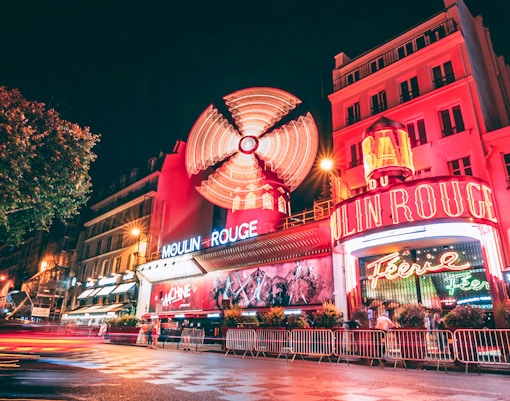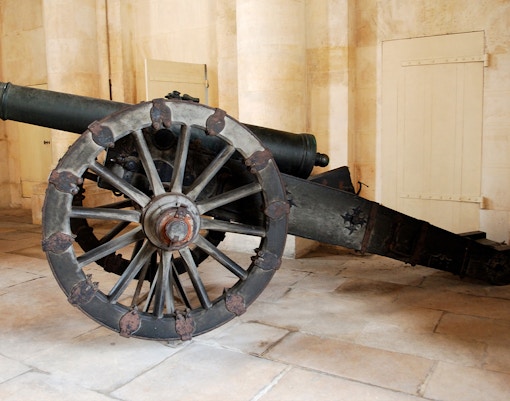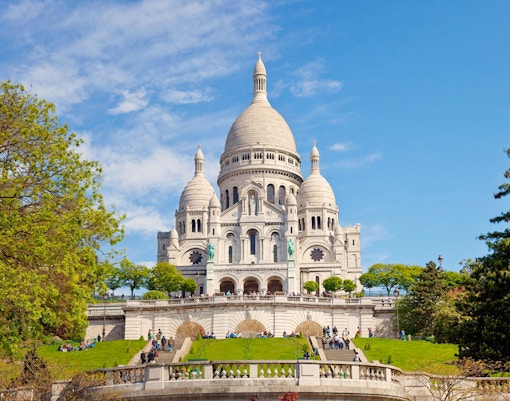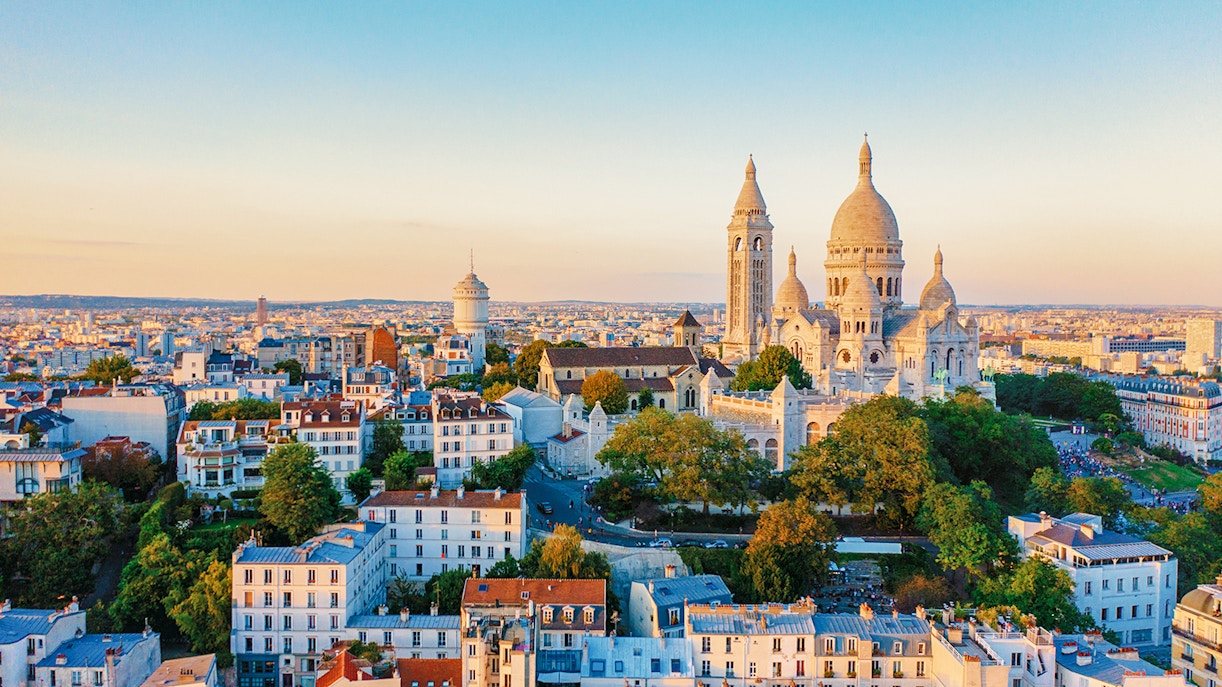- Disneyland® Paris Tickets
- Eiffel Tower Tickets
- Louvre Museum Tickets
- Paris Catacombs Tour & Tickets
- Versailles Tickets
- Notre-Dame Paris Tickets
- Orsay Museum Tickets
- Paris Pantheon Tickets
- Arc De Triomphe Tickets
- Opera Garnier Paris Tickets
- Centre Pompidou Tickets
- Big Bus Paris Hop-on Hop-off Tours
- Sainte Chapelle Tickets
- Les Invalides Tickets
- Eurail Passes
- Musee de l'Orangerie Tickets
- Rodin Museum Tickets
Montmartre History — From its Gallo Roman Beginnings to the Bohemian Roots
Montmartre History Explained

Gallo-Roman Times to Middle Ages
In the embrace of Gallo-Roman times, Montmartre's roots took hold, evident in archaeological remnants. By the 8th century, it bore names like "mons Mercori" and "Mount Mars." The Miracles of Saint-Denis, a pivotal text of 885, recounted the beheading of Saint Denis in 250 AD by the Romans, cementing Montmartre's religious significance and giving it its name. King Louis VI's 1134 acquisition marked the establishment of Saint-Pierre de Montmartre and the Royal Abbey. The village flourished, with vineyards, mills, and a chapel at Saint Denis' martyrdom site, shaping Montmartre's historical and religious legacy.

12th Century to 18th Century
Fast forward to the 12th century, important developments occurred with King Louis VI's 1134 purchase. This led to Saint-Pierre de Montmartre's establishment and the creation of the Royal Abbey. A chapel commemorating Saint Denis' decapitation solidified the area's growing religious importance. By the 15th century, Montmartre had transformed into a village surrounded by vineyards and embraced milling activities. These foundational moments laid the groundwork for Montmartre's evolution into a historical and cultural hub through the 18th century.

French Wars of Religion to 19th Century
From the French Wars of Religion in the late 16th century to the 19th century, Montmartre transformed into a village surrounded by vineyards, gardens, and orchards. It became a strategic location during the 1590 Siege of Paris, when Henry IV placed his artillery on the hill. Over the centuries, mills appeared on the western slope, grinding wheat, barley, and rye. By the late 19th century, Montmartre had gained fame for its cafés, guinguettes, and cabarets, attracting artists like Renoir, Utrillo, and Picasso during the Belle Époque, solidifying its reputation as a bohemian artistic enclave.

Belle Époque and Artistic Renaissance
During the Belle Époque, spanning from 1872 to 1914, Montmartre emerged as a vibrant haven for artists, fostering a cultural renaissance that shaped the neighborhood's identity. With affordable rents and a friendly atmosphere, renowned artists like Renoir, Utrillo, and Picasso flocked to the area, renting studios and creating masterpieces. The iconic establishments Le Chat Noir and Moulin Rouge flourished, becoming epicenters of creativity. Montmartre's narrow streets and cabarets echoed the performances of Yvette Guilbert, Aristide Bruant, and other luminaries, contributing to a unique chapter in the neighborhood's artistic history.

1871 Paris Commune Uprising
In 1871, Montmartre played a pivotal role in the Paris Commune uprising. The French army's attempt to remove cannons stored on the hill triggered a radical response from the politically charged Paris National Guard. The confrontation resulted in the capture and execution of two French army generals, leading to the establishment of a revolutionary government on the heights of Montmartre. This control endured for two months until the French Army, engaging in heavy fighting during the Semaine Sanglante (Bloody Week) in May 1871, successfully reclaimed Montmartre, marking a significant chapter in the tumultuous history of the Paris Commune.

19th to Early 20th Century Developments
From the 19th to early 20th century, Montmartre flourished as a bohemian haven. Annexed to Paris in 1860, it became a hotbed of artistic and cultural activity. The construction of the Basilica of Sacré-Cœur from 1876 to 1919 added a monumental landmark. Georges Clemenceau, later a French prime minister, played a role in local governance. Gypsum mining impacted the area's stability, necessitating unique foundations for Sacré-Cœur. Artists like Renoir, Utrillo, and Picasso lived and worked here during the Belle Époque, fostering a vibrant community that defined Montmartre's historical identity.

World War I and Post-War Era
World War I dealt a blow to Montmartre's artistic vibrancy, prompting the departure of many resident artists to Montparnasse. The bohemian spirit that had defined the area during the Belle Époque faded, with a significant number of artists relocating to Montparnasse. In the post-war era, Montmartre retained its cultural significance, but the artistic landscape changed. Gen Paul, a local artist born in Montmartre, carried on the bohemian tradition. While the neighborhood may have shifted from its earlier artistic zenith, it continued to be a unique blend of history and culture, with a touch of avant-garde.
Montmartre Today

Montmartre today stands as a living testament to its rich history. Its narrow streets, artistic spirit, and iconic landmarks like Sacré-Cœur give you a glimpse into Paris's vibrant past. The neighborhood's cafés, art studios, and unique views contribute to its unique charm. Montmartre's significance lies not only in its historical legacy but also in its ongoing role as a cultural hub. Explore its cobblestone lanes, absorb the artistic ambiance, and connect with the essence of a Paris that has inspired generations of artists and storytellers. Attracting over 10 million visitors every year, Montmartre embodies the soul of Parisian history and creativity.
Get Directions to Montmartre Paris
Book Montmartre Paris Tickets
Frequently Asked Questions About Montmartre History
Montmartre is historically significant as an artistic hub, witness to the Paris Commune, and home to landmarks like Sacré-Cœur, shaping Paris's cultural identity.
Montmartre, dating back to Gallo-Roman times, is over a millennium old.
Montmartre evolved from a 15th-century village with vineyards, witnessing artistic renaissances, revolutionary uprisings, and cultural shifts.
Montmartre showcases diverse styles, including the Romano-Byzantine design of Sacré-Cœur and Romanesque/Gothic influences in Saint-Pierre.
Events like the Paris Commune in 1871, artistic gatherings during the Belle Époque, and World War I significantly shaped Montmartre's history.
Montmartre contributes to Paris's cultural heritage through its artistic communities, unique architecture, and iconic landmarks.
Montmartre was once a separate commune, annexed in 1860. Gypsum mines beneath impacted stability during Sacré-Cœur's construction. Le Clos Montmartre was founded in the nineteenth century to prevent a parcel of land in the heart of the 18th from being converted into a housing development.
Guided tours exploring Montmartre's history are available, offering insights into its artistic legacy, hidden anecdotes, and cultural evolution.



